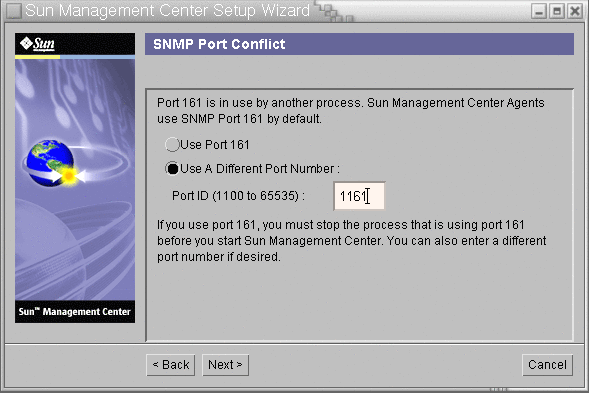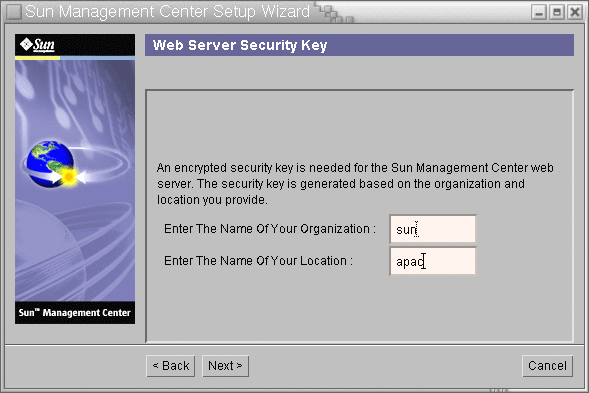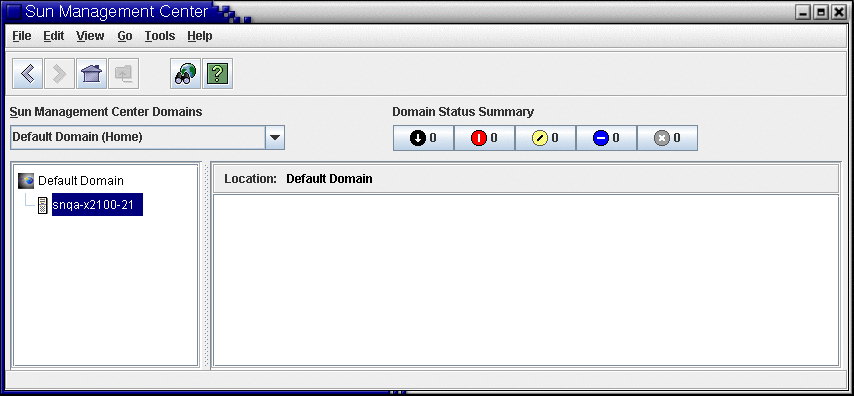Setting Up Sun Management Center
You use the graphical setup wizard to set up, configure, and re-configure your Sun Management Center installation.
For information on using the command-line setup script, see To Set Up Sun Management Center Using the es-setup Script.
 To Set Up Sun Management Center
To Set Up Sun Management Center
-
Set up the installation environment. For more information, see Step 1 in To Install Sun Management Center.
-
Change to the Sun Management Center sbin directory. For example:
# cd /opt/SUNWsymon/sbin
If you installed Sun Management Center in a directory other than /opt, Change to /installdir/SUNWsymon/sbin, where installdir is the directory you specified.
-
Run the set up by typing:
# ./es-guisetup
The Set Up screen appears.
-
Follow the screen prompts.
-
You are given the opportunity to store all of your setup responses in the file /var/opt/SUNWsymon/install/setup-responses-file. The setup-responses-file file is useful if you need to duplicate the setup on the current machine on other machines.
-
To continue setup without creating the response file, click Next.
-
To create the response file, select Store Response Data and then click Next.
-
-
Generate the Sun Management Center security key.
Type a password in both fields and click Next to generate the security keys.
An encrypted security key is needed for communications between all Sun Management Center processes. The key is generated based on the password you provide, which must be between one and eight characters long and contain no spaces. Entries that are greater than eight characters are truncated to eight characters.
Note –Keep a record of the password you use to generate the security key for this machine in a secure location. You might need to regenerate the key for the machine at a later time. You can also change the security key later, if needed, as described in Regenerating Security Keys.
-
Specify the SNMPv1 community security string.
The community string is used for SNMP security and is set to public by default.
Set the community string to a value other than public or private to provide better SNMP security.
 Caution –
Caution – The same SNMP community string must be used on all of the machines on which you install Sun Management Center. If you use different community strings on each machine, SNMP communications between the machines and Sun Management Center components will not work.
-
If you want to accept the community string default value of public, click Next.
-
If you want to use a custom community string:
-
Select Use Custom Community String.
The community string can be up to 255 characters and must not contain any spaces or blanks.
-
Type the same community string in both fields, and then click Next.
-
-
-
Enter a valid Solaris/Linux user name as the UNIX administrator account and click Next.
The setup process checks whether the SNMP port is in use.
-
If the SNMP port is in use, the SNMP Port Conflict screen appears.
Figure 1–4 SNMP Port Conflict Screen

-
Resolve the port conflict.
In most cases, port 161 is the default port assigned to and used by the SNMP daemon. However, other processes or daemons could be using port 161. Several third-party replacements and enhancements for the SNMP daemon exist and could be installed on your system. The Sun Management Center agent is such a daemon.
We recommend that you use a different port number, such as port 1161.
-
To assign a different port number to Sun Management Center:
-
Click Use a Different Port Number.
For instructions on how to find out whether a port is used, see To Determine Whether a Port Is Used.
-
Type the port number, for example, 1161, in the Port ID field and click Next.
Note –Keep a record of this alternate port number. You will need this number if you later install agents using JumpStart or update the Sun Management Center agents using the agent update-image tools.
-
-
To use port 161, select Use Port 161 and click Next.
-
-
If you use port 161, you are reminded to manually stop and disable the SNMP daemon snmpdx.
Note –(On Solaris 10) If you use port 161, you will be reminded to stop and disable the SNMP daemon SMA manually.
There is no SNMP daemon on Linux by default.
-
To stop and disable the SNMP daemon snmpdx automatically, make sure that Stop and Disable SNMP Daemon snmpdx has been selected, and then click Next.
 Caution –
Caution – Stopping and disabling the system SNMP daemon does not guarantee that you have stopped the actual process using port 161. To determine the actual daemon process that uses port 161, you must manually review all /etc/rcN and /etc/rcN.d files, where N is 0 through 6 and S. When you have identified the file that defines the process using port 161, you can disable the process by renaming the file. For example,
/etc/rc3.d# mv S76snmpdx s76snmpdx
You must stop all other processes that use port 161 before you can start Sun Management Center.
-
To stop and disable the SNMP daemon SMA, navigate to the /etc/init.d directory. Type ./init.sma stop.
-
-
If any Sun Management Center ports are in use, you are prompted to resolve the port conflict.
The ports are checked in the following order: trap service, event service, topology service, configuration service, platform agent, cst service, metadata service, database, look-up service, Web server default port, and Web server secure port.
If any of the ports are in use, you are prompted to provide an unused port number. Type an unused port number in the field, and then click Next.
-
Generate the Web server security key.
Figure 1–5 Web Server Security Key Generation

An encrypted security key is needed for the Sun Management Center Web server. The key is generated based on the name of your organization and the name of your location. The names that you provide must not contain any spaces or blanks.
Type the name of your organization and the name of your location to generate the Web server security key and click Next.
For example, you could type admin in the Name of Your Organization field and headquarters in the Name of Your Location field.
Note –Keep a record of the entries you use to generate the security key in a secure location in case you need to regenerate the key for a particular machine at a later time.
-
Confirm setup selections.
The setup process can take from a few minutes to half an hour or more, depending on the products selected.
If base product setup failed, you are informed that the setup of the base products was not successful. You are directed to see the log file for more details. The name of the log file is provided.
-
If you installed add-ons, click Next to set them up.
Some add-on products are included with the Sun Management Center 4.0 installation media. These add-ons are the ones listed in the Select Add-on Products panel. For information on how to set up each add-on, refer to the Sun Management Center supplement for each add-on. Each supplement provides the setup procedure for the specific add-on.
-
Start the product by selecting the components to start and clicking Next.
Figure 1–6 Start Up the Product

For more information on starting and stopping Sun Management Center, see Chapter 8, Starting and Stopping Sun Management Center.
 Caution –
Caution – If your network uses Network Address Translation (NAT), click Close. Use the es-config command-line utility described in To Enable NAT Support to configure the machine for NAT before you start Sun Management Center.
-
-
Start the console by typing this from a terminal window: ./es-start —c&.
The Java Console login screen appears.
Figure 1–7 Console Start Up

Tip –If help does not come up in Java Console, modify the browser path in the javaconsole.properties file. This file is available in /var/opt/SUNWsymon/cfg/ if you have installed the console layer. Otherwise, this file will be available in /opt/SUNWsymon/cfg/.
You are prompted to select the default domain and then a screen similar to this appears.
Figure 1–8 Sun Management Center Default Domain

Note –(On Solaris 10) When Sun Management Center is installed and set up, the services run as Service Management Facility (SMF) services. Based on the layers chosen, appropriate services will be started.
For information on using the product, see Sun Management Center 3.6.1 User's Guide.
- © 2010, Oracle Corporation and/or its affiliates
